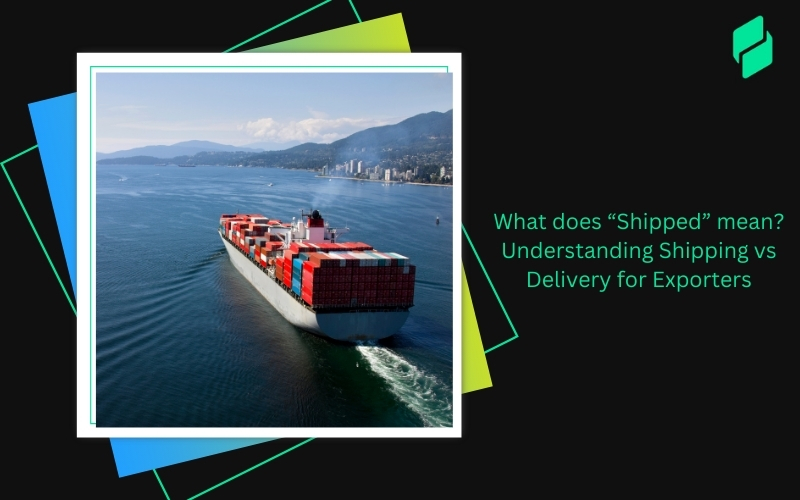Optimize your business: use unlimited savings with Pazago fulfilled now!
Get Started ->Let's face it - navigating the complex world of importing and exporting goods to and from China can be a real headache. With so many regulations, procedures, and documents to keep track of, it's easy to get overwhelmed.
But don't worry, we've got you covered! Understanding China's export procedures and documentation is key to unlocking the vast potential of the Chinese market, and we're here to guide you every step of the way.
This article will discuss the essential steps and requirements for importing and exporting goods to and from China. From export regulations to customs clearance, we'll cover it all. So, are you ready to learn more about China's export procedures and documentation?
Overview of Importing and Exporting in China
China's massive economy and strategic location have made it a global trade powerhouse. Understanding the economic impact, current trends, and key trading partners is essential for businesses looking to tap into the Chinese market.
1. Economic Impact of China's Trade Activities
China's trade activities significantly impact the global economy. As the world's second-largest economy, China's imports and exports account for a substantial portion of global trade.
In 2022, China's exports of goods and services reached USD 3.59 trillion and USD 424 billion, respectively, representing a 7% and 8.1% year-on-year increase. Imports of goods totalled USD 2.71 trillion, and those of services USD 465 billion, with a 1% and 8.9% year-on-year increase, respectively. (Source)
- China's trade activities contribute to:
- Job creation: China's trade sector employs millions of people directly and indirectly.
- Economic growth: Trade activities stimulate economic growth, with exports driving GDP growth and imports providing access to essential goods and services.
- Global trade balance: China's trade surplus or deficit affects the global trade balance, influencing exchange rates and economic policies.
2. Current Trends in China's Import and Export Markets
China's import and export markets constantly evolve, driven by government policies, global demand, and technological advancements. Some current trends include:
- Rise of e-commerce: Online platforms have transformed how Chinese consumers shop, making cross-border e-commerce increasingly popular.
- Shift to high-tech exports: China is moving up the value chain, with high-tech products such as electronics, machinery, and medical equipment becoming a larger share of exports.
- Growing demand for services: China's service sector, including tourism, education, and healthcare, significantly contributes to the country's economy.
3. China's Top Trading Partners and Export Destinations
China's trade relationships are diverse and widespread, and the country has established strong ties with numerous nations.
Some of China's top trading partners and export destinations include: (Source)
- United States: China's largest trading partner, with bilateral trade valued at over $630 billion in 2020.
- European Union: China's second-largest trading partner, with trade valued at over $560 billion in 2020.
- ASEAN countries: China's trade with ASEAN countries, such as Vietnam, Indonesia, and Malaysia, is growing rapidly, driven by the Regional Comprehensive Economic Partnership (RCEP) agreement.
- Latin America: China's trade with Latin American countries, such as Brazil, Mexico, and Chile, is increasing, driven by commodity demand and infrastructure development.
Also read: Exploring Import Procedures and Regulations from China to India
Comparison of Essential Documents for Exporting from China and Importing to China
The following table provides a comparison of the essential documents required for exporting from China and importing to China:
Also read: 10 Required Pre-Shipment Documents for Export Procedure and Shipping Process
Procedures for Exporting from China
Exporting goods from China involves several procedures that must be followed to ensure a smooth and compliant shipping process. Here are the key steps involved in exporting from China:
1. Company Registration with China Customs
The first step in exporting from China is registering the company with China Customs. This involves obtaining a customs registration code, which is required for all exports from China.
2. Documentation Preparation for Export
The next step is to prepare the necessary export documentation, including:
- Commercial Invoice
- Packing List
- Bill of Lading
- Export License (if required)
- Certificate of Origin
- Inspection Certificate (if required)
- Insurance Certificate
3. Export Declaration using China's e-Customs
The export declaration must be submitted to China Customs using the e-Customs system.
This involves submitting the required documentation and information, including the export declaration form, commercial invoice, and other relevant documents.
4. Customs Review and Clearance Process
After submitting the export declaration, China Customs will review the documentation and conduct a customs clearance process.
This involves verifying the accuracy of the documentation, checking the goods against the declared information, and ensuring compliance with relevant regulations and laws.
5. Roles of Different Parties: Domestic Shippers, Freight Forwarders, and Custom Brokers
There are several parties involved in the export process from China, including:
- Domestic Shippers: Responsible for preparing the goods for export, including packaging, labelling, and documentation.
- Freight Forwarders: Responsible for arranging the transportation of goods from China to the destination country, including booking cargo space, arranging customs clearance, and handling logistics.
- Custom Brokers: Responsible for facilitating the customs clearance process, including preparing and submitting the necessary documentation, paying duties and taxes, and ensuring compliance with regulations and laws.
By following these procedures and understanding the roles of different parties involved, exporters can ensure a smooth and compliant shipping process when exporting from China.
Also read: Import and Export Trade: Understanding Its Impact and Strategies In India
Procedures for Importing to China
Importing goods into China involves several procedures that must be followed to ensure a smooth and compliant shipping process. Here are the key steps involved in importing to China:
1. Understanding Import Tariffs and Duties
The first step in importing to China is to understand the import tariffs and duties applicable to imported goods. This includes researching the relevant tariffs, duties, and taxes, as well as any exemptions or concessions that may be available.
2. Entry Procedures and Customs Clearance
The next step is to prepare the necessary documentation for customs clearance, including:
- Commercial Invoice
- Packing List
- Bill of Lading
- Import License (if required)
- Certificate of Origin
- Insurance Certificate
- Importer Security Filing (ISF)
The importer must then submit the entry declaration to China Customs, which will review the documentation and conduct a customs clearance process. This involves verifying the accuracy of the documentation, checking the goods against the declared information, and ensuring compliance with relevant regulations and laws.
3. Quarantine and Inspections for Certain Goods
Certain goods like food, animals, and plants are subject to quarantine and inspection requirements. The importer must ensure that the goods comply with these requirements, including obtaining special permits or licences and undergoing inspections or testing.
4. Compliance with National Safety and Quality Standards
The importer must also ensure that the goods comply with national safety and quality standards, including obtaining certifications or labels, such as the China Compulsory Certification (CCC) mark.
By following these procedures and understanding the roles of different parties involved, importers can ensure a smooth and compliant shipping process when importing to China.
Also read: Top 8 Export Shipping Documentation Software in 2024- A Pazago Guide
China Export Restrictions and Compliance
1. Goods Subject to Export Control Laws
China enforces strict export control laws that regulate specific goods and technologies. Items tubject to these laws typically include military-related products, certain chemical substances, and materials that could be used for weapons development. Exporters must know these regulations to ensure compliance and avoid legal penalties.
2. Technologies and Products Under Strict Control
Certain technologies and products face heightened scrutiny due to their potential military applications or dual-use capabilities. This includes:
- Advanced Materials: High-performance alloys and composites used in aerospace and defence.
- Dual-Use Technologies: Technologies that can serve both civilian and military purposes, such as drones and encryption software.
- AI and Software Solutions: Artificial intelligence applications and algorithms that may enhance military capabilities or surveillance.
Exporters must obtain the necessary licences and approvals before shipping these controlled items.
3. Consequences of Export Violations
Violating China’s export control laws can lead to severe repercussions, including:
- Fines and Penalties: Financial repercussions imposed by regulatory authorities.
- Revocation of Export Licences: Companies may lose their ability to export goods if found in violation.
- Legal Action: Exporters could face criminal charges, leading to imprisonment for responsible parties.
- Reputational Damage: Violations can harm a company’s reputation, affecting business relationships and future opportunities.
4. Prohibited Items
Certain items are orohibited from export due to national security concerns or international obligations. Key categories include:
- Dual-Use Goods: Items that can be used for bivilian and military applications, such as certain technologies and materials.
- Artificial Intelligence Technologies: Advanced AI applications that could be used for surveillance or military purposes.
- Cryptography Products: Encryption software and hardware that may pose security risks if misused.
Common Mistakes to Avoid and Best Practices for Importing to China
When importing goods to China, it's essential to avoid common mistakes that can lead to delays, penalties, and reputational damage. Here are some common mistakes to avoid and best practices to ensure a smooth and compliant import process:
1. Incomplete or Incorrect Documentation
- Mistake: Failing to prepare complete and accurate documentation, including commercial invoices, packing lists, and certificates of origin.
- Best Practice: Ensure tll documentation is complete, accurate, and compliant with Chinese regulations. Verify the accuracy of documentation with suppliers and freight forwarders.
2. Inconsistent or Incorrect HS Codes
- Mistake: Using incorrect or inconsistent Harmonized System (HS) codes can lead to misclassification and customs clearance issues.
- Best Practice: Ensure tS codes are accurate and consistent across all documentation. Consult with experts or use online resources to verify HS codes.
3. Failing to Comply with Inspection and Quarantine Procedures
- Mistake: Failing to comply with inspection and quarantine procedures can lead to delays and penalties.
- Best Practice: Ensure that goods comply with inspection and quarantine procedures, including obtaining necessary permits and licences. Work with experienced freight forwarders and customs brokers to facilitate the process.
4. Ensuring Consistent and Accurate Data Entry
- Mistake: Failing to ensure consistent and accurate data entry can lead to customs clearance issues and delays.
- Best Practice: Ensure tata entry is consistent and accurate across all documentation and systems. Implement robust data management systems and verify data entry with suppliers and freight forwarders.
5. Consulting with Experts and Regular Training
- Mistake: Be sure to consult with experts and undergo regular training, which can lead to non-compliance and mistakes.
- Best Practice: Consult with experts, including customs brokers, freight forwarders, and trade attorneys, to ensure compliance with Chinese regulations. Regularly undergo training and updates on Chinese import regulations and procedures.
Also read: Functional Import and Export Solutions
Get Started with Pazago: Transform Your Trade Operations Today!
Navigating the complexities of China export procedures and documentation can seem daunting,. Still, withthe right guidance and resources, you can turn this challenge into a streamlined process that opens doors to significant business opportunities.
At Pazago, we are dedicated to simplifying every aspect of the import-export journey, empowering you to expand globally faster and more efficiently.
Here’s how we can enhance your trade experience:
- Digital Management: Seamlessly manage your trade journey from procurement to fulfilment with real-time tracking and simplified workflows.
- Proactive Planning: Utilise relevant notifications and auto-reminders to stay ahead in managing your inventory and processes.
- Streamlined Communication: With Pazago's inbox, all key parties can be in one conversation for clear and efficient trade discussions.
- Real-Time Tracking and Alerts: Monitor shipments in real-time and receive immediate alerts for any delays to manage your inventory proactively.
- Comprehensive Logistics: Benefit from reliable cross-border logistics, including ocean shipping and seamless customs clearance.
- Comprehensive Document Management: Create, manage, and collaborate on essential trade documents in one secure location.
By partnering with Pazago, you gain access to essential tools and insights for navigating China export procedures and documentation and position your business for sustainable growth in the global market.


.png)








